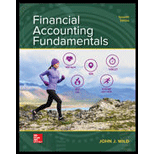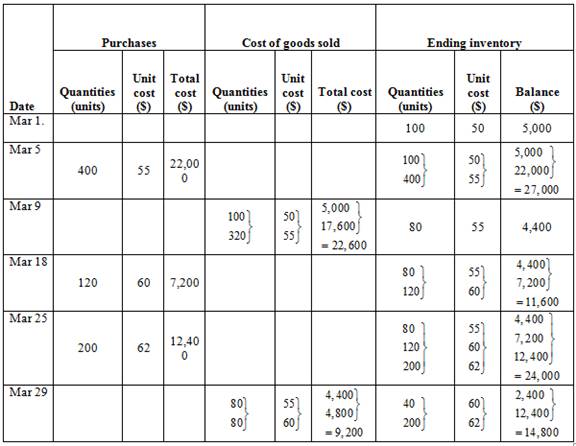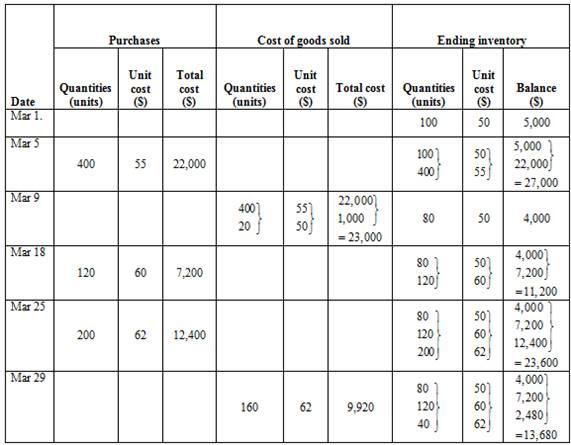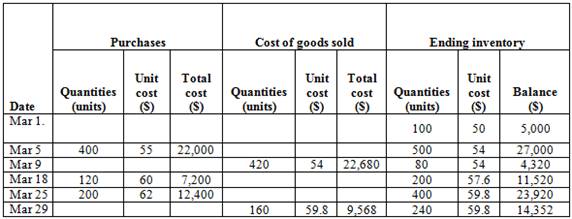
Concept explainers
Perpetual: Alternative cost flows
Warnerwoods Company uses a perpetual inventory system. It entered into the following purchases and sales transactions for March. (For specific identification, the March 9 sale consisted of 80 units from beginning inventory and 340 units from the March 5 purchase; the March 29 sale consisted of 40 units from the March 18 purchase and 120 units from the March 25 purchase.)

Required
- Compute cost of goods available for sale and the number of units available for sale.
- Compute the number of units in ending inventory.
- Compute the cost assigned to ending inventory using (a) FIFO,(b) LIFO, (c) weighted average, and (d) specific identification. (Round all amounts to cents.)
Check (3) Ending inventory: FIFO, $14,800; LIFO, $13,680; WA, $14,352 - Compute gross profit earned by the company for each of the four costing methods in part 3.
(4) LIFO gross profit, $17,980
Inventory:
Inventory refers to the stock or goods which will be sold in the near future and thus is an asset for the company. It comprises of the raw materials which are yet to be processed, the stock which is still going through the process of production and it also includes completed products that are ready for sale. Thus inventory is the biggest and the important source of income and profit for the business.
Perpetual Inventory System:
In perpetual inventory system there is a continuous recording of transactions as and when they take place that is purchase and sale transactions are recorded whenever they occur.
Cost of Goods Available for Sale:
It basically includes the cost of inventory which is ready for sale within an accounting period. It mainly includes the cost of beginning inventory as well as the stock purchased in that year and the production within that period (if any).
Cost of Goods Sold:
Cost of goods sold is the total expenses or the cost incurred by the business during the process of manufacturing of goods and is directly related to the production. It generally includes the cost of raw material, labor and other manufacturing support costs.
Gross Profit:
The profit made after subtracting or debiting the costs related to the goods sold from the total revenue earned or made through sales in a fiscal year is the gross profit.
First in First out: In case of first in, first out method, also known as FIFO method, the inventory which was bought first will also be the first one to be taken out.
Last in First out:
In case of last in, first out, also known as LIFO method, the inventory which was bought in the last will be taken out first.
Weighted Average Cost Method:
In this method the weighted average cost is evaluated after any purchases have been made and transactions are recorded as when purchase or sales take place.
Specific Identification Method:
Under this method, there is a continuous tracking of the inventory and the inventory cost at the time of purchase on the basis of unique identity which thus helps in the valuation of the ending inventory as well as the cost of goods sold. This method is used generally when the company is involved in limited expensive goods which are easily identifiable.
To compute: 1. Cost of goods available for sale and number of units available for sale.
2. Number of units in ending inventory.
3. Cost of ending inventory under the following methods:
- (a) FIFO
(b)LIFO
(c) Weighted average
(d) Specific identification
4. Gross profit for each of the four methods in part
Explanation of Solution
Given info,
| Date | Particulars | Units acquired | Cost per unit ($) | Units sold | Retail price per unit ($) |
| Mar 1 | Beginning inventory | 100 | 50 | ||
| Mar 5 | Purchase | 400 | 55 | ||
| Mar 9 | Sales | 420 | 85 | ||
| Mar 18 | Purchase | 120 | 60 | ||
| Mar 25 | Purchase | 200 | 62 | ||
| Mar 29 | Sales | 160 | 95 | ||
| Total | 820 | 580 |
The ending inventory has,
20 units are from March 1,
60 units are from March 5,
80 units are from March 18 and
80 units are from March 25
1.
Cost of goods available for sale
Formula to calculate Cost of goods available for sale is,
Cost and units of goods available for sale:
| Particulars | Number of units | Cost per unit($) | Amount($) |
| Beginning Inventory | 100 | 50 | 5,000 |
| Purchases: | |||
| March 5 | 400 | 55 | 22,000 |
| March 18 | 120 | 60 | 7,200 |
| March 25 | 200 | 62 | 12,400 |
| Total Purchases | 720 | 41,600 | |
| Available for sale | 820 | 46,600 |
Table (1)
The cost of goods available for sale is $46,600 and the number of units available for sale is 820 units.
2.
Number of units in ending inventory
| Particulars | Number of units |
| Number of units available for sale (given) | 820 |
| Less: units sold (given) | 580 |
| Number of units in ending inventory | 240 |
Table (2)
The number of units in ending inventory is 240 units .
3.
(a)
First in, First out method (FIFO)
Ending inventory

Table (3)
Cost of goods sold
Formula to calculate cost of goods sold is,
Substitute $46,600 for cost of goods available for sale (calculated in part (1)) and $14,800 for cost of ending inventory (as calculated above in the table) in the above formula.
Under FIFO method, the amount of ending inventory is $14,800 and cost of goods sold is $31,800.
(b)
Last in, first out method (LIFO)
Ending inventory

Table (4)
Cost of Goods Sold
Formula to calculate cost of goods sold is,
Substitute $46,600 for cost of goods available for sale (calculated in part (1)) and $13,680 for cost of ending inventory (as calculated above in the table) in the above formula.
Under LIFO method, the amount of ending inventory is $13,680 and cost of goods sold is $32,920.
(c)
Weighted Average Method
Ending inventory

Table (5)
Working Notes:
Calculation of weighted average cost per unit:
Cost of goods sold
Formula to calculate cost of goods sold is,
Substitute $46,600 for cost of goods available for sale (calculated in part (1)) and $14,352 for cost of ending inventory (as calculated above in the table) in the above formula.
Under weighted average method, the amount of ending inventory is $14,352 and cost of goods sold is $32,248.
(d)
Specific Identification Method
Cost of Ending Inventory
| Date of Purchase | Number of units(A) | Cost per unit($)(B) | Amount($) |
| March 1 | 20 | 50 | 1,000 |
| March 5 | 60 | 55 | 3,300 |
| March 18 | 80 | 60 | 4,800 |
| March 25 | 80 | 62 | 4,960 |
| Cost of Ending Inventory | 14,060 |
Table (6)
Cost of goods sold
Formula to calculate cost of goods sold is,
Substitute $46,600 for cost of goods available for sale (calculated in part (1)) and $14,060 for cost of ending inventory (calculated above in the table) in the above formula.
Under specific identification method, the amount of ending inventory is $14,060 and cost of goods sold is $32,540.
4.
Sales are $50,900 (working notes).
Cost of goods sold in case of FIFO is $31,800. (Calculated in part (3(a))
Cost of goods sold in case LIFO is $32,920. (Calculated in part (3(b))
Cost of goods sold in case of weighted average is $32,248 and (Calculated in part (3(c))
Cost of goods sold in case of specific identification is 32,540. (Calculated in part (3(d))
Gross Profit
Formula to calculate gross profit is,
| Particulars | FIFO | LIFO | Weighted average | Specific identification |
| Sales | $50,900 | $50,900 | $50,900 | $50,900 |
| Less: Cost of goods sold | $31,800 | $32,920 | $32,248 | $32,540 |
| Gross profit | $19,100 | 17,980 | $18,652 | $18,360 |
Table (7)
Working notes:
Calculation of sales
The gross profit in case of FIFO it is $19,100, of LIFO it is $17,980, of weighted average it is $18,652 and of specific identification it is $18,360.
Want to see more full solutions like this?
Chapter 5 Solutions
FINANCIAL ACCT.FUND.(LOOSELEAF)
- I am trying to find the accurate solution to this general accounting problem with the correct explanation.arrow_forwardI am trying to find the accurate solution to this general accounting problem with appropriate explanations.arrow_forwardHow can I solve this financial accounting problem using the appropriate financial process?arrow_forward
- Principles of Accounting Volume 1AccountingISBN:9781947172685Author:OpenStaxPublisher:OpenStax College
 Cornerstones of Financial AccountingAccountingISBN:9781337690881Author:Jay Rich, Jeff JonesPublisher:Cengage Learning
Cornerstones of Financial AccountingAccountingISBN:9781337690881Author:Jay Rich, Jeff JonesPublisher:Cengage Learning College Accounting, Chapters 1-27AccountingISBN:9781337794756Author:HEINTZ, James A.Publisher:Cengage Learning,
College Accounting, Chapters 1-27AccountingISBN:9781337794756Author:HEINTZ, James A.Publisher:Cengage Learning,  Intermediate Accounting: Reporting And AnalysisAccountingISBN:9781337788281Author:James M. Wahlen, Jefferson P. Jones, Donald PagachPublisher:Cengage Learning
Intermediate Accounting: Reporting And AnalysisAccountingISBN:9781337788281Author:James M. Wahlen, Jefferson P. Jones, Donald PagachPublisher:Cengage Learning Financial And Managerial AccountingAccountingISBN:9781337902663Author:WARREN, Carl S.Publisher:Cengage Learning,
Financial And Managerial AccountingAccountingISBN:9781337902663Author:WARREN, Carl S.Publisher:Cengage Learning, Financial Accounting: The Impact on Decision Make...AccountingISBN:9781305654174Author:Gary A. Porter, Curtis L. NortonPublisher:Cengage Learning
Financial Accounting: The Impact on Decision Make...AccountingISBN:9781305654174Author:Gary A. Porter, Curtis L. NortonPublisher:Cengage Learning





